VATICAN CITY — Today, taxis, tourists and food carts line the wide piazza in front of St. Peter’s.
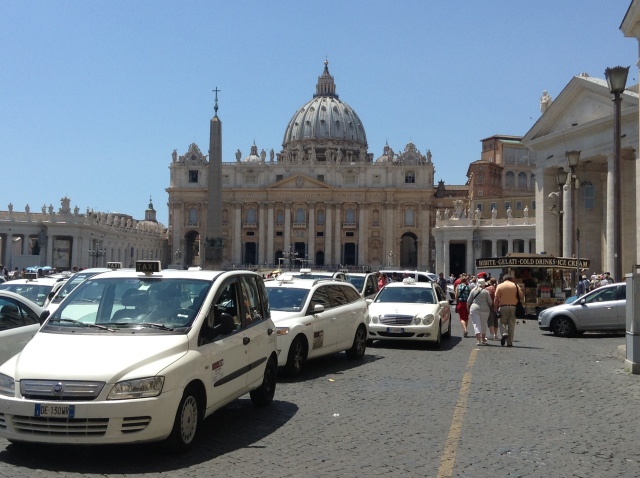
Pius XII Square in front of St. Peter’s Square. (CNS photo/Carol Glatz)
But exactly 70 years ago this week, it was teeming with American tanks, trucks and jeeps, forcing the occupying German troops north and liberating Rome.
June 4, 1944, was the day U.S. troops and Allies reached the Eternal City, freeing it from the insecurities of wartime — hunger, persecution and fear.
A bright floral wreath of yellow and white was quietly hung today under a commemorative plaque on the side of the building that houses the Vatican press office.
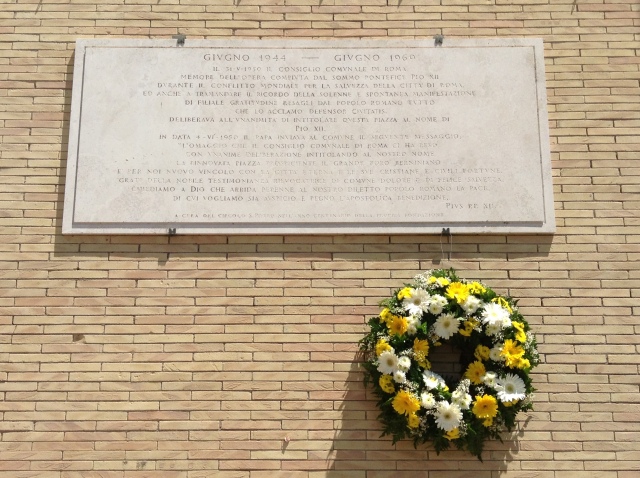
A stone plaque commemorating the role Pope Pius XII played in saving Rome from bloodshed and havoc as the Germans abandoned the city and retreated north on June 4, 1944. (CNS photo/Carol Glatz)
The plaque commemorates the role Pope Pius XII played during and after World War II, but specifically in preventing Rome from becoming a killing field as the occupying Germans fled from advancing American troops.
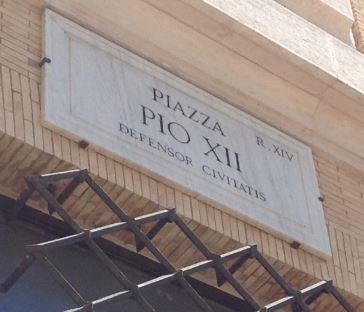
Street sign for Piazza Pius XII. The wartime pope was declared “defender (or protector) of the city” by the city of Rome. (CNS photo/Carol Glatz)
The city of Rome declared Pius XII, “protector of the city,” and named the enormous piazza at the end of the Via della Conciliazione after him.

The late Arcangelo Paglialunga, eyewitness to the liberation of Rome. (CNS photo/John Thavis)
Of the people who were in that square 70 years ago, not many are still alive today.
One eyewitness I interviewed 10 years ago, died in 2011 at the age of 91.
A Vatican reporter for half a century, Arcangelo Paglialunga possessed incredible journalistic accuracy and attention to detail.
His story of that first week in June deserves to be retold — to give sight, sound and the human emotion behind what that wreath of flowers is paying tribute to today:
Veteran Vatican journalist says Pope Pius was WWII savior of Rome
By Carol Glatz, Catholic News Service, June 4, 2004
ROME (CNS) — While the U.S. 5th Army led by Gen. Mark Clark is remembered for being the first Allied troops to march into a Rome free from Nazi occupation, Pope Pius XII is recalled by many Romans as the man who spared the Eternal City from wartime destruction.
When Clark and his troops trundled through Rome on June 5, 1944, the streets were choked with residents cheering and celebrating the end of nine months of a city under siege. But more than 100,000 people later that same day thronged St. Peter’s Square, calling for the pope to come to his window and receive their accolades; Pope Pius XII, they said, was the miraculous savior of Rome.
“Pope Pius XII had done so much. Just think, the last Germans left Rome the evening of June 4th right at the same time the first Americans were coming in. It seemed like a miracle that not a shot had been fired. Nobody died. This was the miracle of Rome,” said Arcangelo Paglialunga, eyewitness to Rome’s liberation 60 years ago and a Vatican journalist for the past half century.
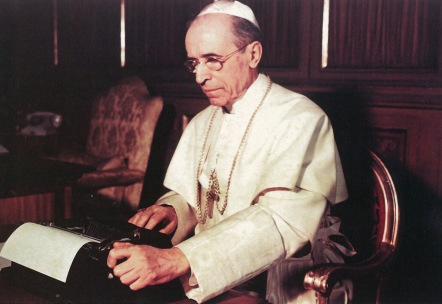
Pope Pius XII writing a wartime Christmas radio messages at the Vatican in this undated photo. (CNS photo/courtesy of Libreria Editrice Vaticana)
Pope Pius had done two things, said Paglialunga: He worked tirelessly convincing Allied leaders to spare Rome from its bombing campaigns, and he called on both the Americans and the Germans to not turn Rome into a killing field by keeping ground combat out of the city.
Through letters, speeches, appeals to (U.S. President Franklin D.) Roosevelt, phone calls, diplomatic maneuverings … the pope did everything to convince both sides to spare the city,” Paglialunga said in an interview with Catholic News Service.
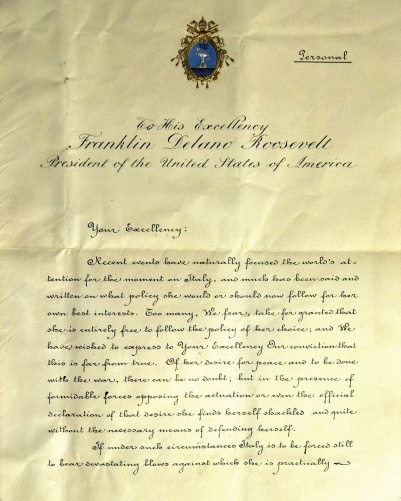
Pope Pius XII wrote this letter to U.S. President Franklin D. Roosevelt, asking the president to spare Rome and its civilian population from further bombings during World War II. (CNS photo/courtesy of Knights of Columbus)
Though the Allies did bomb Rome twice in targeting German positions, ground combat during the Americans’ advance and the Germans’ retreat in June of 1944 was minimal. Also, the rampant vandalism and destruction that marked the Nazi evacuation of Naples had not been repeated.
Paglialunga said the pope was key in the aftermath of the occupation since there was no authority who could deal with the return of Romans who had fled the city.
He said the Vatican organized “by papal order a caravan of trucks that brought people back to their homes.”
The Vatican also “loaded the trucks with grain and foodstuffs from the countryside to alleviate the hunger” that still racked the city, he said.
Paglialunga grew up a few blocks away from the Vatican. His closeness to the church and local religious helped give him an insider’s view into how the Holy See helped Rome during those long months of occupation.
“During the Nazi occupation, the pope had asked Christians to help protect the Jews. I knew the priest at a church nearby who had helped get an older Jewish family hidden in the home of a parishioner. On the morning of the 5th, the priest told me to go to the house and tell the family that the Americans had come — that they were free,” he said.
The young Paglialunga was at first met with incredulity when he brought the family the good news.
“They didn’t believe me. I told them it was true that the Americans were right outside and if they still didn’t believe me I’d go out and bring one back to show them,” he said.
At that point, he said the older Jewish man, his wife and her sister all burst into tears of joy and relief.
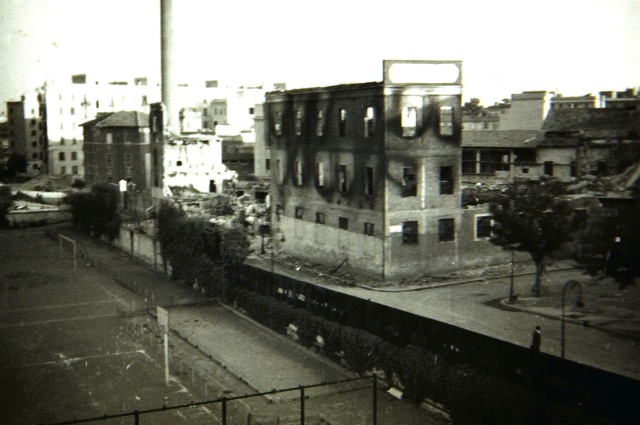
This historic photo shows the Knights of Columbus’ San Lorenzo playground in Rome after a U.S. airstrike during World War II. (CNS photo/courtesy of Knights of Columbus)
Paglialunga, 18 years old at the time, remembers clearly, vividly and with journalistic accuracy those days of Rome’s liberation.
He remembers that on June 5 at 4:30 a.m. “a massive line of tanks came rumbling up the Via della Conciliazione headed toward St. Peter’s.”
Residents, used to long, citywide curfews, spilled into the streets. The main avenue leading to St. Peter’s Square had become a highway of American tanks and troops all driving north in pursuit of the retreating Germans.
“From the tanks, the American soldiers tossed us packs of Chesterfields cigarettes. And then they threw down cans of meat — wieners. It was incredible. After so much hunger you have no idea what it was like to suddenly eat meat from those cans,” he said.
But one of the tanks took a pit stop and parked right in St. Peter’s Square.
“The drivers were obviously Catholic. Instead of following the others up the road north, they came to the square with the tank. They had gone to the basilica to see the church and pray,” Paglialunga said.
The pope, however, did not approve of an armored tank flanking the square.
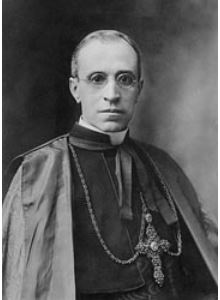
Cardinal Eugenio Pacelli, who became Pope Pius XII, is seen in this 1929 file photo. (CNS photo)
“According to a Vatican memoir, the pope went to his studio, wrote a letter to the American command asking them to move the tank. After a while the tank left, but another one had come and parked in its place,” he said.
After months of intense fighting and many grueling battles to reach Rome, surely there were many soldiers wanting to give a prayer of thanks. Hundreds later turned out for Mass on the first Sunday after the liberation.
“I went to Mass in St. Peter’s Basilica and I saw in the apse what must have been about 400 American soldiers at Mass with their chaplains. When it came time for the collection, two sacristans came out with their small collection canisters. But they didn’t get three yards before the canisters were overflowing with dollars,” he said.
“They had to return to the back of the church and they came out this time with two huge sacks slung around their shoulders. They made the rounds and it was incredible. Those sacks were spilling over with green banknotes,” he said.
In his tiny cubicle in the Holy See press office where he writes for Italian dailies in Venice and Brescia, Paglialunga still proudly displays the first Rome newspaper published after the German occupation ended. On the front page dated June 6, 1944, there is a large black-and-white photo of Clark greeting seminarians from North America in St. Peter’s Square. Just below is a photo of Pope Pius XII delivering his blessing from the central loggia to the tens of thousands of people below.
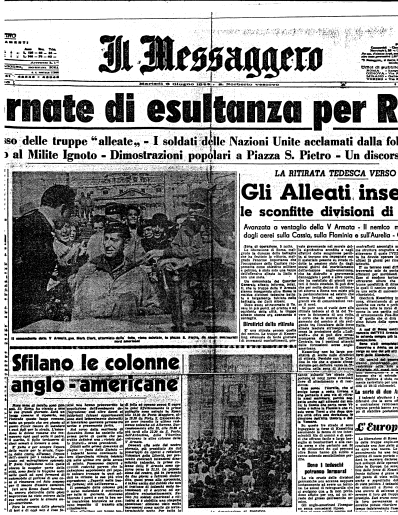
“I remember (the pope) said, ‘Yesterday, Rome was still trembling for the lives of its sons and daughters. … It can now look with new hope and a renewed faith toward its salvation,'” Paglialunga said.
END
For hardcore oral history fans, feel free to read the transcript from the June 3, 2004, interview with Arcangelo Paglialunga at this link: CNS_Paglialunga_memoryof_6_4_44

Reblogged this on Burma as One and commented:
Such an incredible to look back at the history..
Reblogged this on Bengts Blogg and commented:
4 juni för 70 år sedan rullade amerikanska stridsvagnar uppför Via della Conciliazione mot Petersplatsen och befriade Rom från den nazistiska ockupationen. Påven Pius XII betydde mycket i krigets slutskede för att undvika blodbad, och hans insatser, precis som Raoul Wallenbergs i Budapest, räddade många judar från att deporteras till de tyska koncentrationslägren. Den svarta legenden om honom är djupt orättvis. Detta blogginlägg från CNS blickar bakåt till 1949: